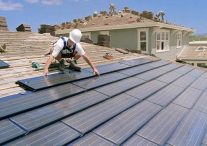For new-build commercial structures, the decision around roofing will be a critical one. Not only must the roof be safe, durable, weatherproof, and light enough to be supported by the underlying building structure, but it must also be cost-effective and in line with the overall architectural vision and design aesthetic. Traditionally, materials such as slate and brick are used, along with concrete and engineered steel and aluminum or tensile fabric structures.
Thermoplastic and EPDM Roofing
Modern alternatives include thermoplastic roofing, which is durable and flexible. It is very good for UV protection and is resistant to chemical exposure, and it lasts for at least two decades. Additional benefits include excellent resistance to high winds and fire. Alternatives include EDPM solutions, which are a very long-lasting type of roof and very easy to install, repair, and maintain.
Solar PV and Green Roofs
These are popular with architects looking to create a ‘green’ solution and can include living roofs and solar PV panels which incorporate energy-generating panels over a rooftop made with glass, tile, or membrane. These are expected to become more popular in the future as businesses seek to lower their carbon footprints.
Looking at Fabric Structures
Why not look at tensile fabric structures? These are a true example of modern engineering, creating beautiful design-led roof forms that could otherwise not be created using traditional roofing methods. Most modern award-winning buildings will use some elements of tensile fabrication, and the technology has been around since the 1970s. Today it allows architects to create stunning works that offer a variety of forms and colors. The structures are also very light, utilizing the properties of tension in order to maintain their 3D form. All of these membrane structures can last for over thirty years, and they are pre-fabricated to exacting specifications using calculations and engineering drawings to suit the exact needs of the building.
The technology can be applied over a range of building elements, including features, entrances, atriums, walkways, exhibitions, retail spaces, landmarks, and more. The resulting structure will be developed and installed by a team of specialist structural engineers, designers, project managers, aluminum fabricators, and membrane fabricators. For an award-winning building that becomes a local landmark, fabric architecture could be the solution.
Contact a roofing specialist for guidance on the right type of roof for your project.

